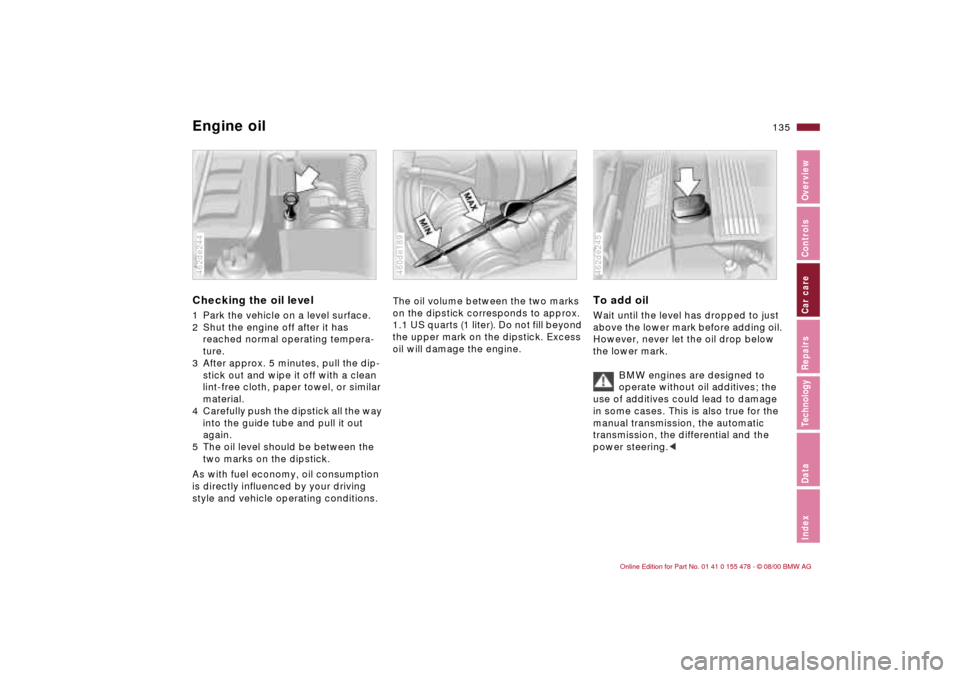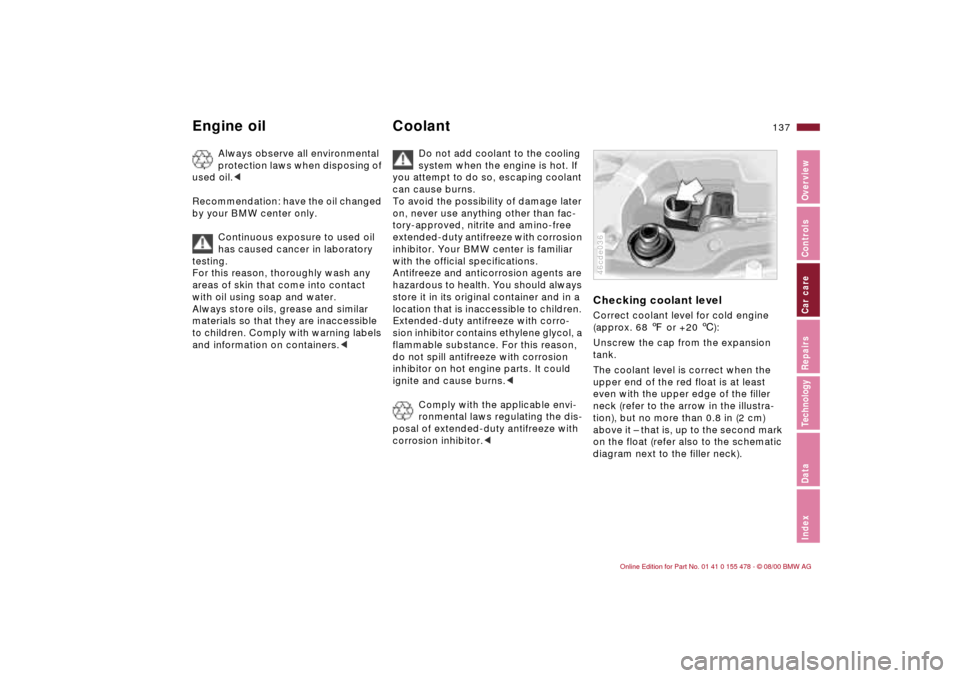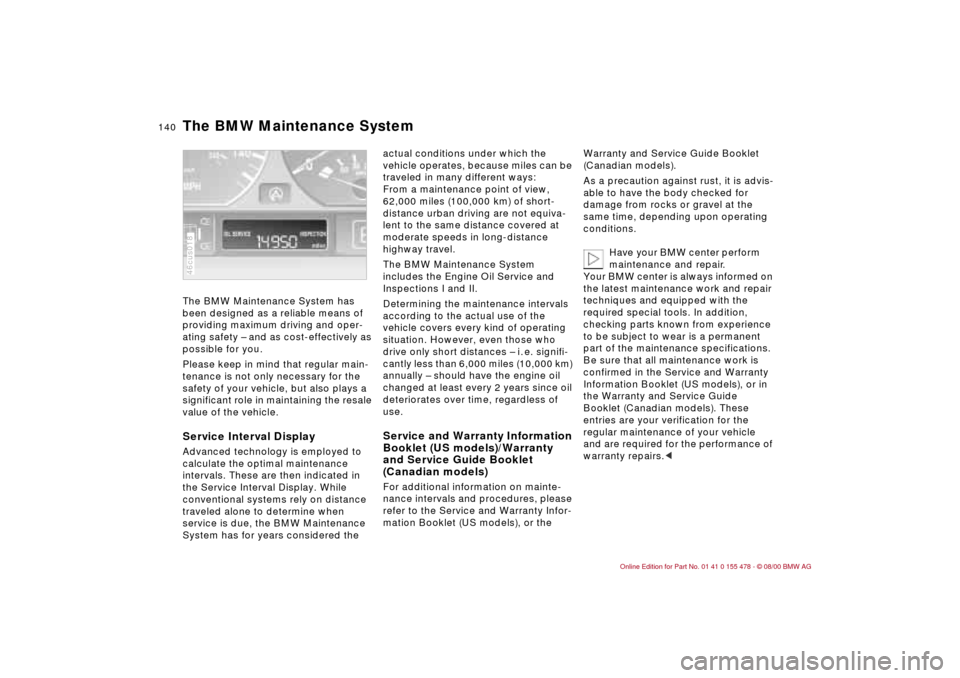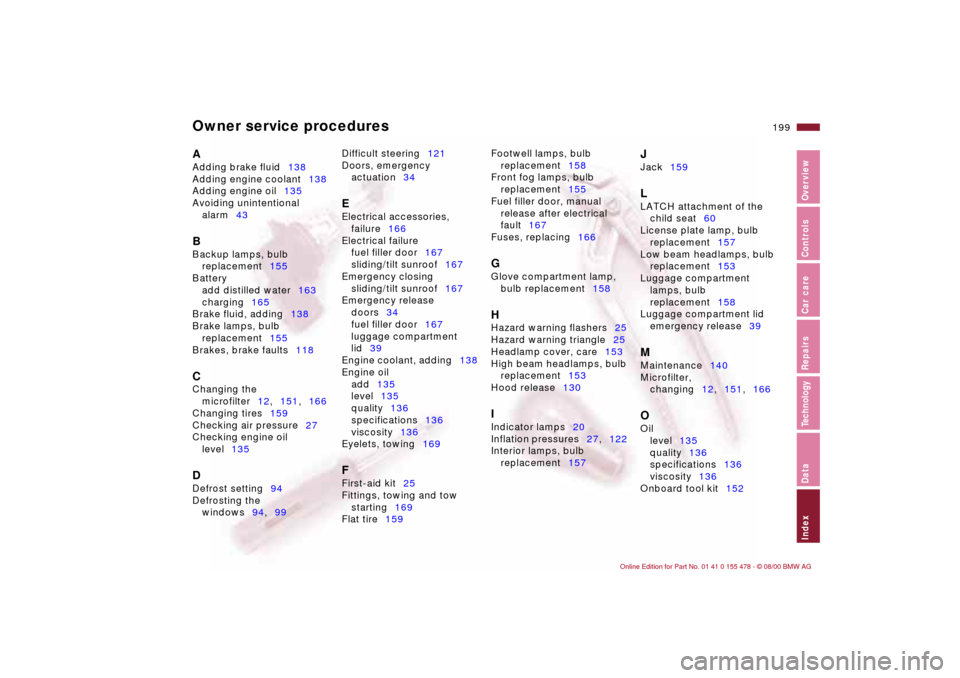2001 BMW 330Ci COUPE checking oil
[x] Cancel search: checking oilPage 76 of 203

76n
Fuel gauge Temperature gauge Service Interval Display When you switch on the ignition, the
indicator lamp comes on briefly to
confirm that the system is operational.
Once the indicator lamp stays on
continuously, there are still approx.
2 gallons (8 liters) of fuel remaining in
the fuel tank.
For fuel tank capacity, refer to page 187.
If the tilt of the vehicle varies (extended
driving in mountainous areas, for
example), there may be slight fluctua-
tions of the needle.
Fill the fuel tank well before it is
empty. Driving to the last drop of
fuel can result in damage to the engine
and/or the catalytic converter.<462us020
BlueThe engine is still cold. Drive at
moderate engine and vehicle speeds.RedWhen you switch on the ignition, the
indicator lamp comes on briefly to
confirm that the system is operational.
If the lamp comes on while operating
the vehicle: the engine is overheated.
Stop and switch the engine off immedi-
ately and allow it to cool down.Between the blue and red zonesNormal operating range. It is not
unusual for the needle to rise as far as
the edge of the red zone in response to
high outside temperatures or severe
operating conditions. Checking coolant
level: refer to page 137.460de082
Remaining distance for serviceThe displays shown in the illustration
appear for a few seconds when the
ignition key is in position 1 or after the
engine is started.
The next service due appears with the
message OILSERVICE or INSPECTION,
together with the distance remaining
before the next scheduled service.
The computer bases its calculations of
the remaining distance on the previous
driving style.
A flashing message and a "Ð" in front of
the number mean that the service
interval has already been exceeded by
the distance shown on the display.
Please contact your BMW center for an
appointment.46cus006
Page 135 of 203

135n
IndexDataTechnologyRepairsCar careControlsOverview
Engine oilChecking the oil level 1 Park the vehicle on a level surface.
2 Shut the engine off after it has
reached normal operating tempera-
ture.
3 After approx. 5 minutes, pull the dip-
stick out and wipe it off with a clean
lint-free cloth, paper towel, or similar
material.
4 Carefully push the dipstick all the way
into the guide tube and pull it out
again.
5 The oil level should be between the
two marks on the dipstick.
As with fuel economy, oil consumption
is directly influenced by your driving
style and vehicle operating conditions.462de244
The oil volume between the two marks
on the dipstick corresponds to approx.
1.1 US quarts (1 liter). Do not fill beyond
the upper mark on the dipstick. Excess
oil will damage the engine.460de189
To add oil Wait until the level has dropped to just
above the lower mark before adding oil.
However, never let the oil drop below
the lower mark.
BMW engines are designed to
operate without oil additives; the
use of additives could lead to damage
in some cases. This is also true for the
manual transmission, the automatic
transmission, the differential and the
power steering.<462de245
Page 137 of 203

137n
IndexDataTechnologyRepairsCar careControlsOverview
Engine oil Coolant
Always observe all environmental
protection laws when disposing of
used oil.<
Recommendation: have the oil changed
by your BMW center only.
Continuous exposure to used oil
has caused cancer in laboratory
testing.
For this reason, thoroughly wash any
areas of skin that come into contact
with oil using soap and water.
Always store oils, grease and similar
materials so that they are inaccessible
to children. Comply with warning labels
and information on containers.<
Do not add coolant to the cooling
system when the engine is hot. If
you attempt to do so, escaping coolant
can cause burns.
To avoid the possibility of damage later
on, never use anything other than fac-
tory-approved, nitrite and amino-free
extended-duty antifreeze with corrosion
inhibitor. Your BMW center is familiar
with the official specifications.
Antifreeze and anticorrosion agents are
hazardous to health. You should always
store it in its original container and in a
location that is inaccessible to children.
Extended-duty antifreeze with corro-
sion inhibitor contains ethylene glycol, a
flammable substance. For this reason,
do not spill antifreeze with corrosion
inhibitor on hot engine parts. It could
ignite and cause burns.<
Comply with the applicable envi-
ronmental laws regulating the dis-
posal of extended-duty antifreeze with
corrosion inhibitor.<
Checking coolant levelCorrect coolant level for cold engine
(approx. 68 7 or +20 6):
Unscrew the cap from the expansion
tank.
The coolant level is correct when the
upper end of the red float is at least
even with the upper edge of the filler
neck (refer to the arrow in the illustra-
tion), but no more than 0.8 in (2 cm)
above it Ð that is, up to the second mark
on the float (refer also to the schematic
diagram next to the filler neck).46cde036
Page 140 of 203

140n
The BMW Maintenance System has
been designed as a reliable means of
providing maximum driving and oper-
ating safety Ð and as cost-effectively as
possible for you.
Please keep in mind that regular main-
tenance is not only necessary for the
safety of your vehicle, but also plays a
significant role in maintaining the resale
value of the vehicle.
Service Interval DisplayAdvanced technology is employed to
calculate the optimal maintenance
intervals. These are then indicated in
the Service Interval Display. While
conventional systems rely on distance
traveled alone to determine when
service is due, the BMW Maintenance
System has for years considered the 46cus018
actual conditions under which the
vehicle operates, because miles can be
traveled in many different ways:
From a maintenance point of view,
62,000 miles (100,000 km) of short-
distance urban driving are not equiva-
lent to the same distance covered at
moderate speeds in long-distance
highway travel.
The BMW Maintenance System
includes the Engine Oil Service and
Inspections I and II.
Determining the maintenance intervals
according to the actual use of the
vehicle covers every kind of operating
situation. However, even those who
drive only short distances Ð i. e. signifi-
cantly less than 6,000 miles (10,000 km)
annually Ð should have the engine oil
changed at least every 2 years since oil
deteriorates over time, regardless of
use.Service and Warranty Information
Booklet (US models)/Warranty
and Service Guide Booklet
(Canadian models)For additional information on mainte-
nance intervals and procedures, please
refer to the Service and Warranty Infor-
mation Booklet (US models), or the Warranty and Service Guide Booklet
(Canadian models).
As a precaution against rust, it is advis-
able to have the body checked for
damage from rocks or gravel at the
same time, depending upon operating
conditions.
Have your BMW center perform
maintenance and repair.
Your BMW center is always informed on
the latest maintenance work and repair
techniques and equipped with the
required special tools. In addition,
checking parts known from experience
to be subject to wear is a permanent
part of the maintenance specifications.
Be sure that all maintenance work is
confirmed in the Service and Warranty
Information Booklet (US models), or in
the Warranty and Service Guide
Booklet (Canadian models). These
entries are your verification for the
regular maintenance of your vehicle
and are required for the performance of
warranty repairs.<
The BMW Maintenance System
Page 197 of 203

Everything from A to Z
197n
IndexDataTechnologyRepairsCar careControlsOverview
Switching off the engine64
Symbols4,164
Synthetic oils136 T
Tachometer75
Tail lamp assembly, bulb
replacement155
Tail lamps155
Tank capacity187
Technical data184
Technical
modifications6,148
Telephone hookup104
Telephone, refer also to the
separate Owner's Manual
Temperature display
outside temperature78
Temperature gauge
engine coolant76
Temperature
layering93,100
Temperature,
adjusting92,98
Thigh support
adjustment49
Third brake lamp157
Three-point-safety belt in the
rear106
Through-loading
system106 Tilt sensor alarm
system36,43
remote control36
Tire
codes125,127
condition122
damage122
inflation
pressure27,122
replacement123
rotation124
tread122
Tire pressure
checking27
monitoring85,179
Tire Pressure Control
(RDC)85,179
Tire Quality Grading123
Tools152
Torque184
Towing eyelets169
Towing the vehicle169
Track185
Traction Control System,
refer to DSC82
Transmission66
Transmitter key32
Transporting children
safely60
Tread depth, tires122
Tread wear indicator122 Trip odometer75
Trunk lid, refer to luggage
compartment lid
Turn signal indicator23,70
bulb replacement154
Turning radius185
Two-way radios121
U
Uniform Tire Quality
Grading123
Used batteries165 V
Vacuum cleaner105
Vanity mirror, bulb
replacement158
V-belts188
Vehicle battery163,188
Vehicle care
exterior142
interior144
Vehicle Identification
Number (VIN)139
Vehicle immobilizer33
Vehicle painting142
Vehicle starting63
Vehicle storage147
Vehicle vacuum cleaner,
attaching105
Vehicle weight186 Ventilation90,93,96
draft-free93,100
Vinyl upholstery, care144
Voice recognition24
W
Warning flashers25
Warning lamp "Please fasten
safety belts"21
Warning lamps20
Warning messages77
Warning triangle25
Warranty and Service Guide
Booklet140
Washer fluids134,187
Washer nozzles,
adjusting134
Washer reservoir, filling134
Washer system70
Washing your vehicle141
Water on roadways113
Waxing, paintwork143
Wear indicator in the
tires122
Weights186
Wheel lug wrench159
Wheel rims125,127
Wheel, changing159
Wheelbase185
Wheels and tires125,127
Width185
Page 199 of 203

Owner service procedures
199n
IndexDataTechnologyRepairsCar careControlsOverview
A
Adding brake fluid138
Adding engine coolant138
Adding engine oil135
Avoiding unintentional
alarm43 B
Backup lamps, bulb
replacement155
Battery
add distilled water163
charging165
Brake fluid, adding138
Brake lamps, bulb
replacement155
Brakes, brake faults118 C
Changing the
microfilter12,151,166
Changing tires159
Checking air pressure27
Checking engine oil
level135 D
Defrost setting94
Defrosting the
windows94,99 Difficult steering121
Doors, emergency
actuation34
E
Electrical accessories,
failure166
Electrical failure
fuel filler door167
sliding/tilt sunroof167
Emergency closing
sliding/tilt sunroof167
Emergency release
doors34
fuel filler door167
luggage compartment
lid39
Engine coolant, adding138
Engine oil
add135
level135
quality136
specifications136
viscosity136
Eyelets, towing169 F
First-aid kit25
Fittings, towing and tow
starting169
Flat tire159 Footwell lamps, bulb
replacement158
Front fog lamps, bulb
replacement155
Fuel filler door, manual
release after electrical
fault167
Fuses, replacing166
G
Glove compartment lamp,
bulb replacement158 H
Hazard warning flashers25
Hazard warning triangle25
Headlamp cover, care153
High beam headlamps, bulb
replacement153
Hood release130 I
Indicator lamps20
Inflation pressures27,122
Interior lamps, bulb
replacement157
J
Jack159 L
LATCH attachment of the
child seat60
License plate lamp, bulb
replacement157
Low beam headlamps, bulb
replacement153
Luggage compartment
lamps, bulb
replacement158
Luggage compartment lid
emergency release39 M
Maintenance140
Microfilter,
changing12,151,166 O
Oil
level135
quality136
specifications136
viscosity136
Onboard tool kit152